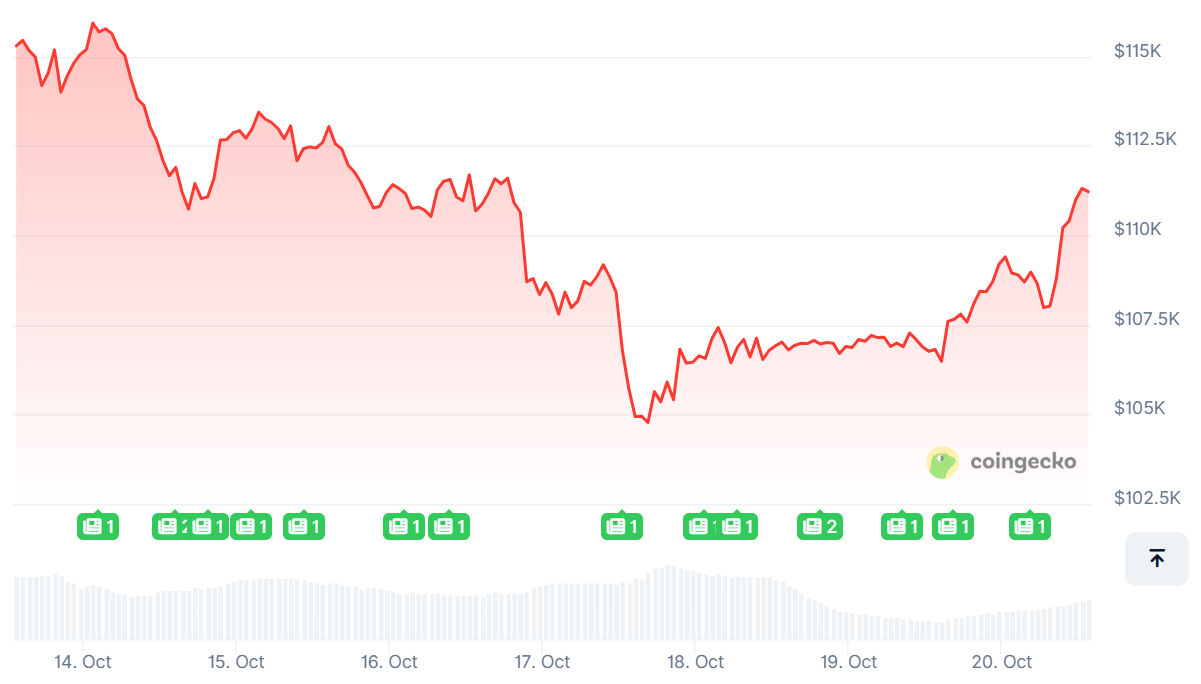Will Cryptos Finally Get the Much-Touted "Uptober" Rally?



Geopolitical headlines have driven the crypto market in recent weeks, with investors treating digital assets as risk bets.
Bitcoin extended its weekend recovery into Monday, with gains 4.2% to above $111,000 after having crashed as much as 4% late last week to about $103,350 to mark the lowest level since June.
During the sell-off last week, over $600 billion was wiped off the crypto market.

The reversal over the weekend and the surge on Monday in crypto came after US President Donald Trump sought to calm trade tensions with Beijing and confirmed his first face-to-face meeting in the current term with Chinese Premier Xi Jinping at the APEC summit next week.
On October 10, the crypto market saw a flash crash, with a record $20 billion liquidated in a few hours of trading, which wiped out over 1.6 million traders.
Bitcoin fell sharply from an all-time high of above $125,000 to below $110,000.
That selloff came after Trump had threatened an additional 100% tariffs on China for its new export rules on rare earth minerals. However, after the market rout, the US President eased his rhetoric and calmed investor nerves by saying high tariffs were not sustainable.
That clearly reflects geopolitical headlines driving crypto markets, which had failed to hold onto its tag as a safe-haven asset.
On the other hand, gold hit repeated records, surging to near a new all-time high og $4,400 an ounce last week during the turmoil in broader markets, including cryptos.
Worst October in 10 Years?
October has often been referred to as "Uptober" among crypto traders, reflecting the month’s historical propensity for significant rallies in Bitcoin.
However, this year's performance is on track to be the most disappointing since 2015, with a fall of 5% so far.
October typically has a historical average of about 20%, while November stands out with an impressive 42%, making it the most robust month for the asset.
Broader economic and geopolitical risks have overshadowed seasonal trends.
The ongoing tariff conflict between the US and China, coupled with low liquidity and a series of leveraged washouts, has collectively limited potential gains.
Last week's drop of Bitcoin below $107,000 resulted in an additional $1.2 billion in liquidations, eliminating long positions that had been established following the rebound in September.
The week saw Ethereum, Solana, and BNB decline 4-7%, while smaller tokens such as DOGE and ADA experienced a significant drop of over 20%.
The red streak this October is not without precedent, yet it remains an uncommon event.
In the past 12 years, Bitcoin has experienced a monthly close below its previous level on just two occasions — in 2014 and 2018, with the latter marking a decline of 3%.
In 2020, Bitcoin experienced a remarkable turnaround, shifting from a loss in early October to a significant 27% rally by the end of the month, paving the way for record highs in the subsequent year.
With a fortnight remaining, the schedule still presents opportunities for a turnaround.
Despite the macroeconomic challenges, market participants are betting that a Fed rate cut this month, along with a premature conclusion to the current phase of quantitative tightening, will boost cryptos again.
The CME Group's FedWatch Tool presently shows a 98.9% probability that the Fed will cut rates by 25 basis points at the meeting next week.
The Tale of Two Parts
The 2025 story for cryptos marks two different phases.
The first phase saw cryptos rising in unison with gold as a safe harbor asset, while in recent weeks, that trend has been broken somewhat.
Bitcoin's breach above the $100,000-mark for the first time ever was driven by safe-haven demand alongside gold's surge.
Financial institutions took advantage of the crypto market's spike to new highs.
In a mad dash, issuers applied for an overwhelming number of exchange-traded funds (ETFs) connected to alternative cryptocurrencies (altcoins), which are assets that reside on the fringes of digital finance and are notoriously unpredictable and little traded.
However, in the recent phase, cryptos have traded more like extreme risk assets.
Significant amounts of market capitalization have evaporated as altcoins have experienced sharp declines, highlighting the persistent illiquidity and volatility of numerous assets in this space.
Several tokens have experienced a decline of about 70% in the past week, with bids vanishing as liquidity has diminished.
It serves as a harsh reminder that significant portions of the digital asset landscape continue to reflect a chaotic financial frontier, despite the efforts of product developers to adapt them for compliant markets.
The current market slump is a good example of those worries.
About 130 applications for ETFs associated with smaller crypto tokens are currently with the US Securities and Exchange Commission for review, according to data gathered by Bloomberg Intelligence.
This includes funds related to Polkadot, Chainlink, and Pengu, the memecoin connected to Pudgy Penguins.
Initially launched as a humorous concept in 2013, Dogecoin now boasts a functioning ETF trading under the ticker DOJE , attracting $38 million in inflows.
However, following the market downturn, there are no smiles to be found. The current downturn, while not as tumultuous as the 2022 digital-asset crisis, is nonetheless prompting fresh concerns.
Fears about pressures in the credit market reignited a downturn in prices on Friday, with an index of altcoins plummeting by as much as 11%, reaching its lowest point since April.
This serves as a clear indication of how quickly a whole landscape of speculative assets can be eliminated.
The current administration has inspired issuers to pursue more adventurous products, motivated by the White House’s favorable approach to digital assets. Certain filings also feature double-leveraged instruments that monitor the Trump and Melania cryptocurrencies.
Still, traders bet on the broader crypto market to get a boost, with the next sustainable leg up expected from the Fed's policy easing.
Elsewhere
Podcast
Jeff Feng Talks Sei Network's Vision for the Future of Trading
Sei Labs co-founder Jeff Feng unpacks the core value of blockchain as a trading engine, the strategic importance of Singapore's talent pool, and how high-speed infrastructure is quietly powering the next wave of Web3 in gaming, social, and even genetic data.
We're a media partner for the upcoming Singapore Fintech Festival! Use the promo code SFFSMPBH for 20% off all delegate passes at this link !

Markets Hold Breath for CPI, China’s Next Move
Your weekly macro cheat sheet...

Bitcoin Tests Resistance: Will the Bulls Break Through or Buckle?
After reclaiming $110K, Bitcoin eyes a breakout above $111,250, but mixed technical signals—from bul...

From Panic to Stability: Crypto Rebounds as $100 Billion Flows Back Into Market
Your daily access to the back room....

